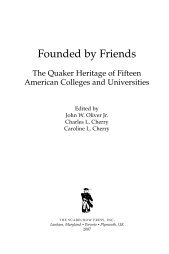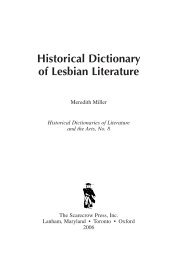What Is Documentation? - Scarecrow Press
What Is Documentation? - Scarecrow Press
What Is Documentation? - Scarecrow Press
You also want an ePaper? Increase the reach of your titles
YUMPU automatically turns print PDFs into web optimized ePapers that Google loves.
viii Preface<br />
Professional activities, for Briet, can only be viable given an understanding<br />
of social and cultural space—and “culture” must be understood not just<br />
in terms of the sociology of production within individual scientific and scholarly<br />
disciplines, but also in regard to larger cultural, social, and historical<br />
horizons within which these disciplines, as well as documentation, may find<br />
or imagine itself. <strong>What</strong> Briet identifies as the failures of librarianship (and<br />
which her work in founding the reference room at the Bibliothèque nationale<br />
worked against) lies in its professional negligence for proactive engagement<br />
with, and on behalf of, these different cultures. For Briet, documentation<br />
is not only “dynamic,” but it is also a dynamism of “prospection”<br />
(“research,” or literally as our translation has rendered it, “prospecting”).<br />
<strong>Documentation</strong>, as Briet puts it elsewhere, must be like the “dog on the<br />
hunt,” sniffing out new knowledge within and at the boundaries of established<br />
networks, resources, and materials, especially in fast-moving fields of<br />
research. And in doing so, it not only acknowledges, but also fits with, the<br />
new “rhythms” of production made possible by technology, which Briet understands<br />
as efficient and expansive.<br />
These and other theoretical observations regarding documentation’s relation<br />
to culture make Briet’s book of value not only to Library and Information<br />
Studies, but also to cultural studies, rhetoric, and science and technology<br />
studies. The rhetorical and theoretical brilliance that characterize Briet’s<br />
book have, perhaps, never been replicated in library and information publications<br />
and have rarely been seen in professional texts of any type. Not<br />
again—until Actor Network Theory at the end of the twentieth century—<br />
would a social network account of technical production, and specifically,<br />
documentary production, be articulated. Briet’s comprehension of the integration<br />
of technology and technique, of machines and culture, is something<br />
that we still strive to understand in both Library and Information Studies and<br />
in science and technology studies. In terms of education and scholarship,<br />
there remains a large gulf between prescriptive, professional education and<br />
the study of larger cultural concerns, traditionally engaged in the liberal arts.<br />
Briet, however, points to the necessity of understanding and taking measure<br />
of the cultural categories, the historical lineages, and the social forces that<br />
produce, support, and continue a profession. She demands that documentalists<br />
be proficient in two foreign languages, that they consider the position of<br />
their work within a cultural specialty and within culture and society as a<br />
whole, that their orientation and specialized vocabularies originate from the<br />
cultural specialization which they serve, and that they see documents as assuming<br />
varieties of physical forms and formats. Briet believes that documentalists<br />
have as part of their mandate exploring at, and beyond, the boundaries
















